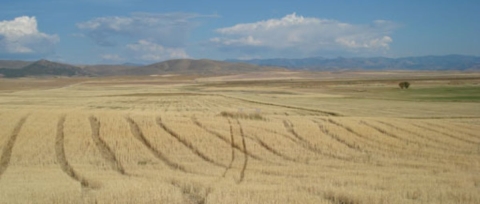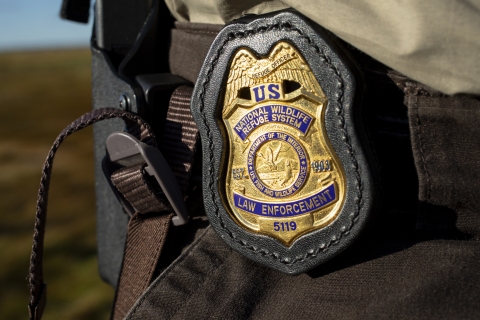What We Do
The Service manages Oxford Slough Waterfowl Production Area (WPA) as a food crop area, using barley, for migratory bird use. The area also has planted Dense Nesting Cover composed of taller native grasses which is used heavily by nesting birds and provides safer nesting from predators. No grazing is allowed. The western portions of the unit are hayed to maintain wet meadow areas and wildlife foraging habitat and also provides a fire break for any fires that may occur during the summer that may threaten Oxford. The eastern and southern portions of the WPA are maintained as deferred or untouched units with native grasslands for more secure nesting habitat.
Management and Conservation
Weed Control
Control of non-native, invasive weeds is another key management operation. Weed pests have few natural controls and can quickly replace native Idaho plants. The WPA uses selected herbicides and biocontrols to keep these problem plants under control.
Undisturbed Habitat
The WPA also maintains abundant habitat in an undisturbed, natural state. These areas provide tall, dense vegetation for species that prefer seclusion for nesting. It also provides escape cover from predators, such as striped skunks, raccoons, red foxes and mink.
Fire Management
Prescribed fire is used periodically in the more densely vegetated areas of the marsh. It creates open water ponds in the marsh after re-flooding and recycles nutrients that increase plant growth, resulting in improved habitat and markedly increased use by waterfowl.
Comprehensive Conservation Planning
Refuge conservation plans are called “comprehensive conservation plans” (CCPs). The purpose of a CCP is to specify a management direction for the Refuge for the next 15 years. The goals, objectives, and strategies for improving Refuge conditions—including the types of habitat we will provide, partnership opportunities, and management actions needed to achieve desired conditions – are described in the CCP. The Service’s preferred alternative for managing the Refuge and its effects on the human environment, are described in the CCP as well.
The Oxford Slough Waterfowl Production Area is included with Bear Lake National Wildlife Refuge in the WPA's and Refuge's Comprehensive Conservation Plan: https://ecos.fws.gov/ServCat/DownloadFile/165926
Law Enforcement
Law enforcement is essential to virtually every aspect of wildlife conservation. The Office of Law Enforcement contributes to Service efforts to manage ecosystems, save endangered species, conserve migratory birds, preserve wildlife habitat, restore fisheries, combat invasive species invasive species
An invasive species is any plant or animal that has spread or been introduced into a new area where they are, or could, cause harm to the environment, economy, or human, animal, or plant health. Their unwelcome presence can destroy ecosystems and cost millions of dollars.
Learn more about invasive species , and promote international wildlife conservation.
Service law enforcement today focuses on potentially devastating threats to wildlife resource-illegal trade, unlawful commercial exploitation, habitat destruction, and environmental contaminants. The Office of Law Enforcement investigates wildlife crimes, regulates wildlife trade, helps Americans understand and obey wildlife protections laws, and works in partnership with international, state, and tribal counterparts to conserve wildlife resources. This work includes:
- Breaking up international and domestic smuggling rings that target imperiled animals
- Preventing the unlawful commercial exploitation of protected U. S. species
- Protecting wildlife from environmental hazards and safeguarding critical habitat for endangered species
- Enforcing federal migratory game bird hunting regulations and working with states to protect other game species from illegal take and preserve legitimate hunting opportunities
- Inspecting wildlife shipments to ensure compliance with laws and treaties and detect illegal trade
- Working with international counterparts to combat illegal trafficking in protected species
- Training other federal, state, tribal, and foreign law enforcement officers
- Using forensic science to analyze evidence and solve wildlife crimes
- Distributing information and outreach materials to increase public understanding of wildlife conservation and promote compliance with wildlife protection laws
If you have any questions about Law Enforcement or Rules & Regulations on the Refuge, please call the Southeast Idaho Refuge Complex office at 208-237-6615, x 109.
Laws and Regulations
Hiking
Hiking is permitted in the Waterfowl Production Area (WPA) year-round. There is only one short entrance road; most of the WPA has no roads. Caution should be exercised as much of the WPA is marshy and can be impassable depending on the time of year.
Access
Please respect the property rights of others. Permission should be obtained from adjacent landowners before crossing private land to enter open portions of the WPA.
Cross-country Skiing and Snowshoeing
Those who choose to enjoy the refuge in this manner are welcome. As with any winter activities, caution and safety should be foremost in visitors' minds.
Vehicles and Parking
Use of any motorized vehicles and bicycles is permitted on the short graveled entrance road leading to the parking area.
Please check with the Southeast Idaho NWR Complex at 208-237-6615, x 112 if you have questions or concerns. Be safe and have fun!



